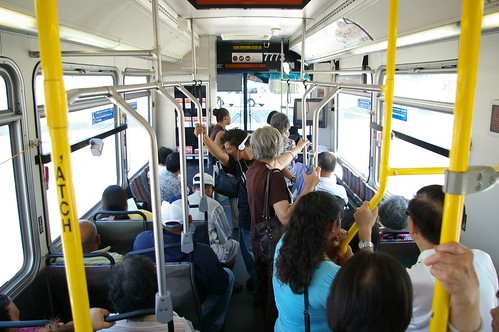Most humans are social creatures – we enjoy the company of others (typically) and others enjoy our company. However, anyone who rides public transit on a regular basis knows that chatting it up with a stranger or sitting next to someone on an empty bus are pure violations of an unspoken set of social rules.

Another example: when a bus nears full, the objective becomes finding a seat next to a non-weirdo. And when the bus is full, well... stand next to a non-weirdo. Image by Flickr user fredcamino.
Believe it or not, this type of behaviour has actually been researched and has been coined, “nonsocial transient behaviour” or NTB. NTB in layman terms are strategies used by people to keep strangers away. Based on two years of study, Esther Kim, found that bus users employ a number of tactics to avoid sitting next to the “weirdo” which include:
- Avoiding eye contact with other people
- Leaning against the window and stretch out your legs
- Placing a large bag on the empty seat
- Sitting on the aisle seat and turn on your iPod so you can pretend you can’t hear people asking for the window seat.
- Placing several items on the spare seat so it’s not worth the passenger’s time waiting for you to move them.
- Looking out the window with a blank stare to look crazy
- Pretending to be asleep
- Putting your coat on the seat to make it appear already taken
- If all else fails, lie and say the seat has been taken by someone else
According to the research paper, the reasons for this type of disengagement is related to: uncertainty about strangers, lack of privacy or absence of a personal space, and exhaustion.
So why is this the case? Is there is something inherently unnerving and disconcerting with buses? Or has bus travel simply been a victim of stereotyping for the past decades, which has caused most people to view it as a “lower” class of travel?
Should this be the case, perhaps what we need a little more in our lives are these “Norwegian style” bus campaigns.

5 Comments
It might have to do with the differences in seating and travel time. Planes are expected to fill up, seating is frequently pre-assigned, the ride is going to be at least half an hour and people figure they’ll make the best of it. Transit buses are short-distance sit-as-you-can affairs, so there’s incentive to avoid any long-duration social contacts.
And a stranger might be an advance scout for a Hun raiding party. You just have to be careful about these things.
Good points. I do agree about the short term time and distances associated with transit buses.
However, one thing to note is that the study focused on Greyhound bus rides. So I’d imagine that these trips would typically take, at least a couple of hours – similar to that of a plane ride.
Well.. to state the obvious – bus commuter clientele are typically a little “rougher around the edges” than airplane passengers. Not exactly the type of people you’d strike up a conversation with….
rough around the edges prolly means more interesting to talk to tho
I think this comes down simply to seat assignments. There’s a major carrier in my area, Southwest, that doesn’t assign seats. If the plane isn’t completely full, I’ve witnessed very similar neighbor-avoidance techniques as I see on buses.
I’d also like to point out a friend’s technique on bus rides she knows will fill up: she chooses her neighbor. She looks around and finds the person she’d most like to sit next to, based on appearance, even if there are empty seats. This way she avoids having the smelly, creepy guy come in and sit next to her.